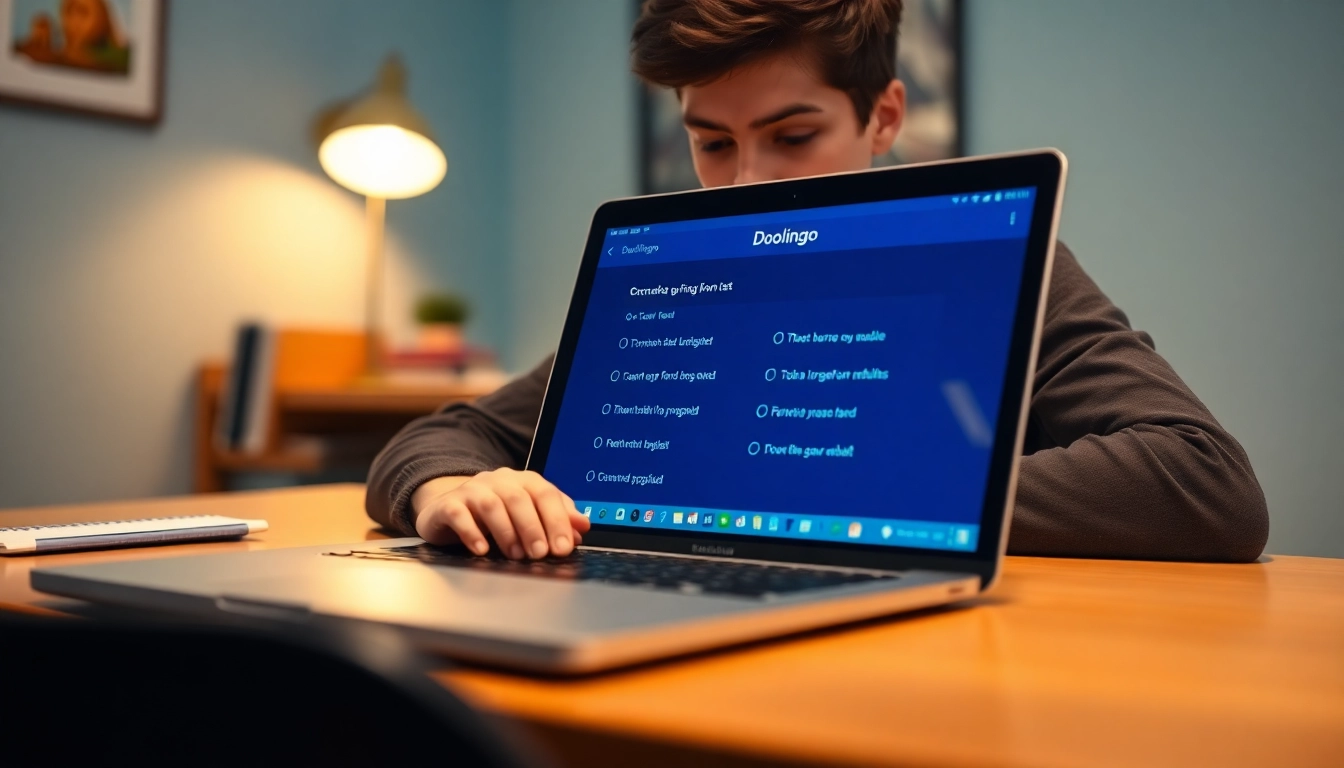Understanding the Duolingo English Test
What is the Duolingo English Test?
The english test duolingo is an innovative online assessment designed to evaluate English language proficiency. Launched by Duolingo, the test leverages technology to offer a comprehensive evaluation of an individual’s reading, writing, listening, and speaking skills. Unlike traditional tests, the Duolingo English Test can be taken from the comfort of your home, providing a flexible and accessible option for candidates worldwide.
The test is particularly popular among students aiming to meet language requirements for universities, as well as professionals seeking to validate their English skills internationally. The results are typically accepted by numerous institutions, becoming a preferred choice over traditional assessments like IELTS or TOEFL due to its convenience and quick turnaround time for scores, generally within 48 hours.
Test Format and Structure
The Duolingo English Test lasts about 60 minutes and is divided into several sections that assess different language skills. The structure consists of:
- Adaptive Questioning: The test uses an adaptive format, which means questions become more challenging based on your performance. This system allows a more accurate measure of your skills; each section dynamically adjusts to your level.
- Integrated Skills Assessment: The test evaluates multiple skills simultaneously. For example, you may be required to listen to a passage, summarize it, and answer questions simultaneously, reflecting real-life communication scenarios.
- Video Response: You will record your responses to various prompts that assess your speaking skills. This portion evaluates clarity, pronunciation, and fluency, simulating real-world interactions.
Overall, the blend of written and spoken evaluations offers a robust snapshot of a candidate’s English proficiency.
Importance of the English Test Duolingo
The significance of the Duolingo English Test lies in its alignment with the modern requirements of language assessment. As globalization continues to shape educational and professional landscapes, the ability to communicate effectively in English has become essential. The test’s growing acceptance by many institutions around the world makes it a formidable alternative to long-standing tests like TOEFL and IELTS.
Additionally, the Duolingo English Test provides a unique solution for those who may find traditional testing environments intimidating. Its online format and adaptive questioning can reduce test anxiety and improve test performance. Through accessibility and an innovative structure, the test not only measures a learner’s proficiency but also promotes a positive testing experience.
Preparing for the English Test Duolingo
Effective Study Strategies
Preparing for the Duolingo English Test requires a strategic approach that encompasses all four language domains: reading, writing, listening, and speaking. Here are some effective strategies to enhance your preparation:
- Immerse Yourself in English: Surround yourself with the English language through podcasts, books, movies, and conversation. This immersion helps reinforce vocabulary and grammatical structures naturally.
- Practice Regularly: Consistency is key. Setting aside dedicated time each day to practice each language skill can help reinforce learning and retention.
- Use Mock Tests: Taking practice tests can help familiarize you with the test format and timing. Many resources, both paid and free, provide sample questions that mimic the exam environment.
- Engage in Interactive Learning: Platforms that offer interactive speaking and language exercises can boost your confidence and fluency. Conversational exchange apps can provide real-world practice.
Resources for Practice
There are numerous resources available for preparing for the Duolingo English Test. Here are some popular options:
- Duolingo App: The Duolingo language-learning app offers exercises that enhance your vocabulary and grammar skills, including speaking and listening components.
- Practice Tests on Official Duolingo Site: The official Duolingo English Test website provides free practice tests and resources for candidates to familiarize themselves with the exam format.
- YouTube Tutorials: Various educators and language experts share tips and strategies for mastering the Duolingo English Test. These resources often include valuable insights and examples.
- Conversation Partners: Engaging with native English speakers or fellow learners can create a practical speaking practice experience that is invaluable for proficiency development.
Common Mistakes to Avoid
Understanding common pitfalls can help improve your chances of success. Here are mistakes to avoid:
- Neglecting to Practice Speaking: Many candidates underestimate the importance of speaking practice. Make sure to dedicate time to this area, as it is a crucial component of the test.
- Overlooking the Listening Section: Given that some sections require fast comprehension, not practicing adequate listening skills can be detrimental. Enhance these skills through listening exercises.
- Ignoring Feedback: If using a tutor or practice partner, take feedback seriously. Constructive criticism can be immensely helpful in identifying areas that need improvement.
- Not Managing Time Effectively: The adaptive nature of the test means some questions may take longer than expected. Practice pacing yourself during your preparations to ensure you can complete all sections in the allotted time.
Test Day: What to Expect
Pre-Test Checklist
Preparing for test day requires careful planning to ensure you have everything needed for your online exam. Here’s a checklist to help:
- Ensure you have a stable internet connection.
- Use a reliable computer or device with a working camera and microphone.
- Familiarize yourself with the testing platform through practice tests.
- Choose a quiet, well-lit location free of distractions.
- Gather identification documentation, as it may be required for verification in some jurisdictions.
Navigating the Test Environment
On test day, it’s vital to remain calm and focused. Here’s what you can expect:
- Environment Verification: Prior to beginning, you may need to show your ID and provide a panoramic view of your testing area to ensure no prohibited resources exist.
- Technical Setup: You will be guided through checks to ensure your camera and microphone are functional.
- Instructions Review: The test will begin with a clear set of guidelines, explaining the format and how to navigate through questions.
Understanding Scoring and Results
Upon completion, understanding how results are generated is essential. The Duolingo English Test is scored on a scale from 10 to 160, with benchmarks set for different proficiency levels:
- 10-55: These scores indicate limited proficiency, where test-takers may struggle to communicate effectively.
- 60-85: Scores in this range reflect a basic conversational ability, suggesting that the test-taker can handle some interactions but may require support.
- 90-115: This range suggests intermediate proficiency, indicating that the candidate is capable of functioning in academic or professional environments.
- 120-160: Scores above 120 represent advanced proficiency, with adequate language skills to thrive in English-speaking contexts.
Post-Test: Next Steps
Interpreting Your Scores
After receiving your results, interpreting them can guide your next steps. Here are key points to consider:
- Compare your score with the requirements of institutions or programs you wish to apply for.
- If your score is lower than expected, assess areas for improvement and consider retesting after additional preparation.
- Remember that a higher score not only reflects proficiency but enhances chances of acceptance in various academic and professional settings.
Using Your Results for Institutions
Depending on your goals, your Duolingo English Test results can be pivotal. Here are tips on how to utilize your scores:
- Research the score requirements for your targeted schools or organizations. Many institutions publicly list their minimum score criteria for the Duolingo English Test.
- Include your scores in applications, emphasizing the validity of your English language proficiency.
- If necessary, reach out to admissions offices to discuss your score and reinforce additional qualifications or experiences.
Continuous Improvement Tips
Regardless of your test results, continuous improvement in language skills is always beneficial. Here are some strategies:
- Set clear goals for different aspects of the language to maintain motivation and progress.
- Engage in an ongoing language learning community or find a conversation partner to practice regularly.
- Utilize resources such as language apps, online courses, or local classes to further hone your skills.
FAQs about the Duolingo English Test
How does the Duolingo test compare to IELTS?
The Duolingo English Test and IELTS assess similar language proficiency skills, but there are fundamental differences. While IELTS is a traditional, in-person examination focused on assessing English for academic and professional purposes, the Duolingo test is entirely online, allowing you to take the exam at your convenience. Moreover, Duolingo often reports quicker results, enhancing its appeal to students with time sensitivity—however, some institutions may still prefer IELTS for field-specific criteria.
What is a good score for the Duolingo English Test?
A good score typically depends on the institution and program requirements. Generally, a score above 120 is regarded as strong, indicating advanced proficiency, while scores between 90-119 usually meet basic academic admission standards. Understanding your target programs’ score expectations will help determine what constitutes a “good” score for your particular situation.
Tips for passing the English test Duolingo
Here are essential tips for successfully passing the Duolingo English Test:
- Prioritize learning and practicing vocabulary relevant to your field of study or work.
- Focus on enhancing your speaking skills through consistent practice and recordings.
- Utilize various learning resources, including apps, courses, and study groups, to diversify your methods.
- Apply time management strategies during tests to ensure you pace yourself effectively.



